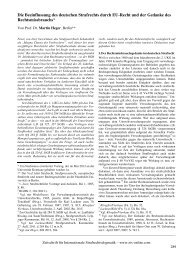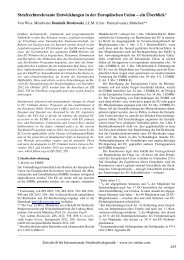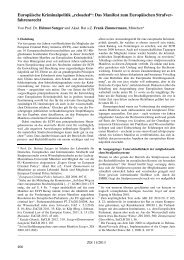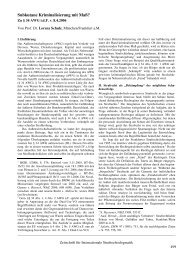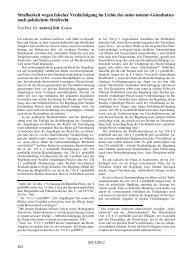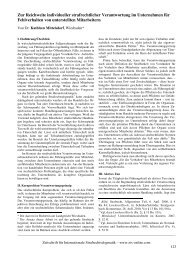Inhalt AUFSÄTZE ANHANG - ZIS
Inhalt AUFSÄTZE ANHANG - ZIS
Inhalt AUFSÄTZE ANHANG - ZIS
- No tags were found...
Create successful ePaper yourself
Turn your PDF publications into a flip-book with our unique Google optimized e-Paper software.
On Functional Perpetration in Dutch Criminal Law_____________________________________________________________________________________but unimaginative, fused with his function which he oftenconsiders as a vocation. Finally, at the top level reside theleaders who combine charismatic qualities with strategicinsight and organizational skills. At each level ‘functionaries’take pride in their skills and accomplishments, but the greatestrespect is owed to the political and military leaders, preciselybecause high intelligence and personal charisma arescarce talents among human kind (especially when combinedin one individual). Obviously, the leader’s prestige reinforcesthe authority and control he wields over his men.For (international) criminal law, dealing with system criminality,it is crucial to take the function of the accused aspoint of departure for the determination of his guilt. For onething, his function perfectly captures his contribution to thecrime and sheds a clear light on the actus reus. From thisperspective, the crime is the shadow of his function. But apartfrom this, his function may be indicative of the accused’position within the hierarchy and the relations he has withothers within the system.It is an accepted principle of criminal law that the sentenceshould reflect the measure of guilt and responsibility. Inthis respect the concepts of Organisationsherrschaft andfunctional perpetration offer sufficient opportunities for carefuldistinction. The political and military leadership does notonly incur criminal responsibility for the international crimes,but also for the creation and preservation of the illegal systemas such. 29 The mid-level man who copies his superior’s modeof operation by making use of fungible executioners doingthe dirty work, bears no responsibility for the system as such,but is liable for the international crimes over which he exercisescontrol. 30 Perhaps it is a bit contrived to hold the midlevel man responsible on the basis of Organisationsherrschaft.After all, the concept connotes dominion of the willover persons and events, whereas the mid level man is fullydependent on the decisions of his superiors. 31 It demonstrates29 Vest, Humanitätsverbrechen – Herausforderung für dasIndividualstrafrecht?, ZStW 113 (2001), 493: “Entsprechendunterscheidet sich seine Verantwortung für Aufbau, Organisationund Aufrechthaltung der verbrecherischen Institutionals solcher, die als Organisationsherrschaft zu bezeichnenist”.30 Vest (Fn. 29), 494 makes a useful distinction between „Organisationsherrschaftinnerhalb des Apparates’“ and “Organisationsherrschaftüber den Apparat“: “Sie (id est: the former)steuern “nur”ein Teilgeschehen, indem – und solange –sie das Funktionieren der Institution modifizieren“.31 Compare Ambos (Fn. 23), p. 153 who first acknowledgesthat “the possibility of an Organisationsherrschaft at differenthierarchical stages has been recognized and that this controlitself grows and accumulates with increasing power ofdecision-making and the availability of personnel resources”.Later on, however, he qualifies this point of view by addingthat “From all this it follows that the doctrine of Organisationsherrschaftcan only convincingly be applied to men inthe background, whose orders and instructions cannot withoutany further ado be revoked or cancelled, i.e. those who, inthe need of a flexible approach, in which concepts of criminalresponsibility are juxtaposed and fine tuned to the specificrelation between the perpetrator and the crime and betweenthe perpetrators inter se. 32Functional perpetration, being a broader concept than Organisationsherrschaftas it lacks the latter’s rigid and preciserequirements, may cover a wider array of indirect perpetratorsat different levels, but equally does not obviate the applicationof modes of participation whenever these are moreappropriate in a specific situation.IV. A Future in International Criminal Law?In the previous section I have tried to demonstrate that functionalperpetration bears close conceptual affinity to Organisationsherrschaft,at least when applied in the context oflarge state apparatus which engage in systemic crime, andthat the Dutch concept, like its greater nephew, has greatpotential to establish responsibility for high level and midlevel indirect perpetrators.The final issue which has to be addressed is whether theseconcepts stand a real chance of being used and applied by theInternational Criminal Court and international criminal tribunals.This question requires immediate qualification. Obviously,it would be presumptuous to claim that a parochialconcept as functional perpetration should be accepted ‘lock,stock and barrel’ by international criminal tribunals. Rather Iintend to explore whether Organisationsherrschaft and itsLatin American equivalents have made inroads in internationalcriminal law, arguing that the kindred concept of functionalperpetration may sustain their further reception.The critical test to which those concepts are exposed iswhether they have a solid foundation in the normativeframework of international criminal law. By their very nature,concepts of criminal responsibility cannot meet theexacting and precise demands that the nullum crimenprincipleimposes on the elements of crimes. 33 However, asexpounded by the ICTY’s Appeals Chamber in the Tadićcase,the kindred principle of nulla poena sine culpa requiresthe concept to be firmly established in customary internationallaw and, in addition, that it falls within the ambit of theStatute. 34this sense, can rule and control without any interference(from above)” (154).32 In the same vein, Ambos who favours qualification of themid level man as indirect perpetrator with regard to crimeswhich took place under his control ( but not in respect of thewhole chain of events) and co-perpetrator on the basis offunctional division of power.33 Compare Article 22 of the Rome Statute.34 For the discussion of this requirement: Prosecutor v. Tadić,IT-94-1-A, 15 July 1999, §§ 185-187. The Appeals Chamberheld that the notion of common design (Joint Criminal Enterprise)complied with this requirement (§ 220). For a criticalappraisal of this point of view, see Boot, Nullum Crimen SineLege and the Subject Matter Jurisdiction of the InternationalCriminal Court, 2002, p. 302. See also Prosecutor v. Stakić,IT-97-24-A, 22 March 2006, in which the Appeals Chamber_____________________________________________________________________________________Zeitschrift für Internationale Strafrechtsdogmatik – www.zis-online.com619




